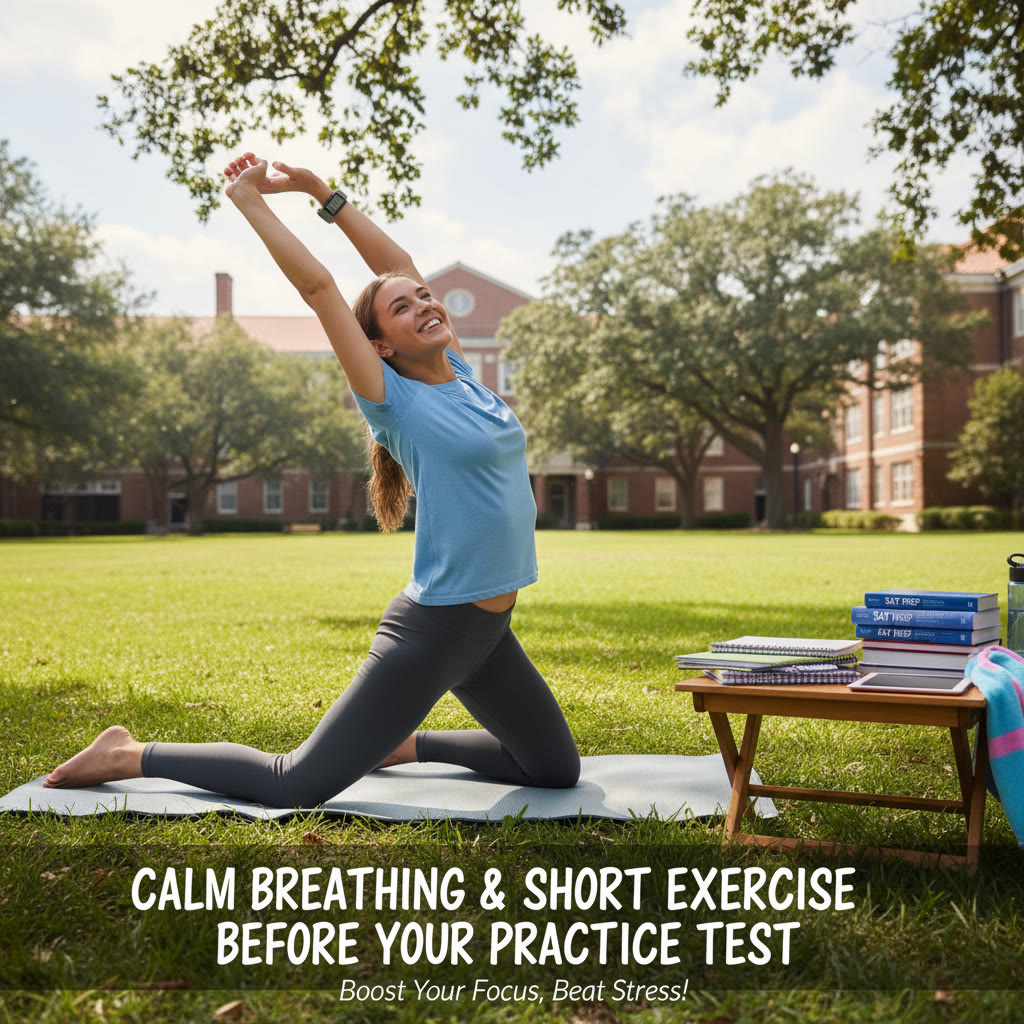Why We Need to Talk About Stress and SAT Practice Tests
Let’s be honest: taking practice SATs can be as nerve-racking as the real thing. You sit down with a stack of questions, a ticking clock, and the quiet hum of expectation. For many students, practice tests are meant to be growth tools — safe spaces where mistakes become lessons. Yet when stress sneaks in, that safe space can feel anything but safe. Scores drop, confidence wobbles, and the study plan derails.
This post walks through what stress actually does to your brain and your practice-test performance, offers realistic and research-backed strategies you can use immediately, and shows how tailored support — like Sparkl’s personalized tutoring — can help you practice smarter, not harder. No panic attacks, no miracle cures: just clear explanations, useful examples, and practical steps that fit into a student’s life.
What Happens to Your Brain Under Stress
Stress isn’t just a feeling; it’s a biological reaction. Short-term (acute) stress triggers a cascade: your body releases adrenaline and cortisol, your heart rate rises, and your attention sharpens — great if you need to sprint out of danger, less great when you must calmly analyze a sentence or solve a geometry problem.
Key cognitive systems affected by stress during a practice SAT:
- Working memory: Stress reduces the brain’s ability to hold and manipulate information. That makes multi-step math problems and dense reading passages harder.
- Attention and focus: You may find your mind wandering or hyper-focusing on a single question and losing track of time.
- Processing speed: Under pressure, reaction times can either accelerate (causing careless mistakes) or slow (causing time trouble).
- Metacognitive control: Your ability to monitor your performance and adjust strategies — for example, skipping a tough question — worsens under stress.
Acute vs. Chronic Stress: Different Problems, Different Solutions
It helps to distinguish acute stress (the spike you feel when the clock starts) from chronic stress (ongoing worry about scores, college admissions, family expectations). Acute stress can sometimes sharpen performance in the short-term. Chronic stress, however, quietly erodes concentration, sleep quality, and learning capacity over weeks and months — the very things that matter for steady score improvement.
How Stress Shows Up on Practice Test Scores
Stress doesn’t just make you feel bad — it changes the pattern of mistakes you make. Recognizing those patterns helps you target your practice.
Common stress-driven score effects
- Careless errors: Rushing under time pressure can lead to avoidable slips, like misreading numbers or skipping negative signs.
- Timeouts and incomplete sections: Fixating on a hard question because anxiety makes you afraid to move on.
- Poor reading comprehension: When working memory is taxed, long passages become foggy and details slip away.
- Overconfidence or underconfidence: Stress can flip your self-assessment — you might abandon correct approaches or needlessly switch strategies.
An illustrative example (Maya’s practice test)
Maya, a junior, averaged 630 on practice Reading sections during untimed review but saw that average dip to 610 on full, timed practice tests. She noticed the drop wasn’t because she didn’t know the content; rather, under timed conditions she lost track of the main point of passages and made more “one-line” mistakes. Once she started practicing timed passages under low-pressure simulation and using short breathing breaks between passages, her timed average rose, and careless errors decreased.
Data Snapshot: How Different Stress Levels Affect Practice Behavior (Illustrative)
Below is a compact table showing plausible, illustrative differences in behavior across stress levels. These figures are meant to guide thinking — individual experiences vary.
| Stress Level | Common Effects | Typical Outcomes on a Practice Test |
|---|---|---|
| Low | Clear focus; steady pacing | Fewer careless errors; sections finished on time |
| Moderate | Mild distraction; occasional time pressure | Some skipped questions; slight drop in accuracy |
| High | Racing thoughts; difficulty retrieving info | Many careless errors; incomplete sections; big score variance |
Why Practice Tests Sometimes Make Stress Worse
Practice tests are double-edged. They’re essential — they build stamina, reveal weaknesses, and teach timing — but they can also reinforce anxiety if administered or reviewed poorly.
- High-stakes mindset: Treating every practice test like the final exam can turn a learning opportunity into a pressure cooker.
- Poor review habits: If your reflection focuses only on the score instead of specific error patterns, you’ll walk away discouraged rather than informed.
- Missing gradual exposure: Some students jump straight to full-length, timed tests without building up with shorter, lower-pressure practices first.
How to Use Practice Tests Without Increasing Anxiety
Practice tests should be structured as experiments. Here’s a simple routine:
- Decide in advance what you want to learn from the test (timing, specific question types, endurance).
- Run the test in a realistic environment, but remove unnecessary pressure — tell yourself it’s data, not destiny.
- During review, separate score from error analysis: one session to record the numbers, another to dissect mistakes and create targeted drills.
Practical Strategies to Reduce Stress and Boost Practice-Test Performance
These strategies are practical, evidence-informed, and student-friendly. You don’t need to overhaul your life — just add intentional practices that make a measurable difference.
Before the Test: Build a Stress-Resilient Routine
- Sleep: Aim for consistent sleep, especially before practice tests. Memory consolidation and attention depend on it.
- Nutrition and hydration: A balanced meal with protein and complex carbs helps stable energy levels; bring a water bottle for the real test.
- Light exercise: A short walk or dynamic stretches 30–60 minutes before a practice session can lower cortisol and improve focus.
- Warm-up questions: Start with 5–10 untimed, high-confidence questions to build momentum.
During the Test: Small Rituals, Big Impact
- Paced breathing: If you feel a wave of anxiety, practice 4-4 breathing (inhale 4s, exhale 4s) for 20 seconds to steady your heart rate.
- Checkpoint mindset: After each section or passage, pause for 10 seconds: breathe, recalibrate, and set a small goal for the next section.
- Strategic skipping: Train yourself to skip and mark hard questions quickly. Returning with fresh focus is often more efficient than getting stuck.
After the Test: Review with Curiosity, Not Judgment
How you review practice tests determines whether they become stepping stones or sources of stress. Adopt a detective mindset: identify what went wrong, why, and what you’ll change.
- Classify errors: Was it content knowledge, careless mistake, time pressure, or misreading?
- Create micro-drills: If you missed algebraic manipulation repeatedly, build 10 targeted problems and mix them into your daily practice.
- Track trends, not single events: One bad practice test is a data point, not a verdict. Watch for patterns across three to five tests.
Study Techniques That Reduce Cognitive Load
Reducing the mental burden frees up your brain for the real work: solving SAT problems. Here are techniques with strong practical value.
Spacing and Interleaving
Instead of cramming a single topic for hours, spread short practice sessions over days and mix problem types. Spacing strengthens long-term memory; interleaving trains you to switch strategies under varying conditions — exactly what test day demands.
Retrieval Practice
Testing yourself on material improves recall more than passive review. Use flashcards for vocabulary and quick math formulas, and integrate short, timed retrieval quizzes into your week.
Error Logs and Checklists
Maintain a simple error log: question type, mistake cause, and corrective action. Over time, this becomes a map of your stress triggers and knowledge gaps.
Simulating Pressure—Gradually
Simulation is the bridge between calm practice and confident performance. But it should be done gradually:
- Start with untimed or lightly timed sections.
- Introduce small stressors: background noise, a stricter time limit, or back-to-back sections to build endurance.
- Work up to full-length, timed tests in realistic environments.
This graduated exposure helps you learn coping strategies in manageable doses so that, when the real test arrives, what once felt intense becomes familiar and manageable.
How Personalized Tutoring Helps Manage Stress
Personalized coaching can be a game-changer because a tutor does more than teach content — they teach how to learn under pressure. Here’s how targeted support reduces stress and improves practice performance:
- 1-on-1 guidance: A tutor can spot the specific error patterns that show up only under pressure and then design drills to correct them.
- Tailored study plans: Instead of a one-size-fits-all schedule, personalized plans pace practice and simulation to prevent burnout and steadily build confidence.
- Expert feedback: Immediate, specific feedback shortens the learning loop — fewer repeated mistakes, and less anxiety about what to do next.
- AI-driven insights: When combined thoughtfully with human coaching, AI can highlight trends in timed performance and suggest targeted interventions to reduce stress-triggered errors.
Sparkl’s personalized tutoring blends these benefits into a study routine that recognizes the emotional side of test prep. Tutors help students practice under realistic conditions, normalize mistakes, and focus on the behaviors that reliably improve scores — not just the raw number on a single practice test.
A Practical 4-Week Plan to Reduce Test-Day Stress
Here’s a condensed, practical schedule focused on both skills and stress resilience. Adjust intensity based on your school workload and energy levels.
- Week 1 — Baseline & Short Sessions:
- Take one untimed diagnostic section per day (40–60 minutes total).
- Start an error log and begin 10 minutes of light exercise daily.
- Week 2 — Introduce Time Pressure:
- Two timed sections per week; focus on pacing. Short, calm breathing routines before each section.
- Daily retrieval practice (vocab/formulas) for 15 minutes.
- Week 3 — Simulated Full Tests:
- One full-length practice test under realistic conditions; review with error classification.
- Incorporate strategic skips and quick-check rituals in every practice.
- Week 4 — Focus & Refinement:
- Two short full-length tests, spaced early and late in the week to practice recovery strategies.
- Work with a tutor or mentor to refine timing strategies and finalize a calm pre-test routine.
The Role of Mindset: From Threat to Challenge
How you interpret stress matters. When you view stress as a threat, your body tightens and cognitive resources narrow. When you view it as a challenge, your body allocates resources to performance and problem-solving. Small mindset shifts — reframing stress as a sign your body is ready to perform — change physiological responses and improve performance.
Practice a short affirmation before practice tests, such as: “This is a chance to learn, not to prove.” It sounds simple because it is—small cognitive shifts add up.
Quick Reference: What to Do When You Panic During a Practice Test
- Stop for 10 seconds and breathe deeply (4-4 breaths).
- Remind yourself: this is practice, a chance to gather data.
- Use the skip strategy: mark the question, move on, and come back with fresh focus.
- After the test, log the moment: what triggered the panic and what you’ll change next time.
Final Thoughts: Turning Stress from an Enemy into a Tool
Stress will appear in your SAT prep — that’s normal. The difference between a frustrating practice experience and a productive one lies in how you respond. By understanding the cognitive mechanics of stress, building a gradual exposure plan, refining review habits, and using targeted support like Sparkl’s personalized tutoring, you transform anxiety into feedback. Practice tests stop being judgment and start being information — fuel for steady improvement.
Remember: progress is rarely a straight line. Expect plateaus and occasional backsliding. What matters is that each practice test gives you clearer data about your strengths, your stress triggers, and the small, actionable changes that lead to better scores.
Image Ideas


Parting Note
Be kind to yourself. Preparing for the SAT is as much about learning how you operate under pressure as it is about content mastery. When you intentionally practice with awareness — using graded simulations, error logs, small rituals, and personalized feedback — the score on a practice test stops being a verdict and becomes a stepping stone. If you’d like help building a plan that fits your life and reduces the stress that lowers your practice-test scores, consider reaching out for tailored support; a combination of expert tutors, 1-on-1 guidance, and AI-driven insights can speed up progress and make practice feel more human and less lonely. You’ve got this — one measured, mindful practice at a time.















No Comments
Leave a comment Cancel